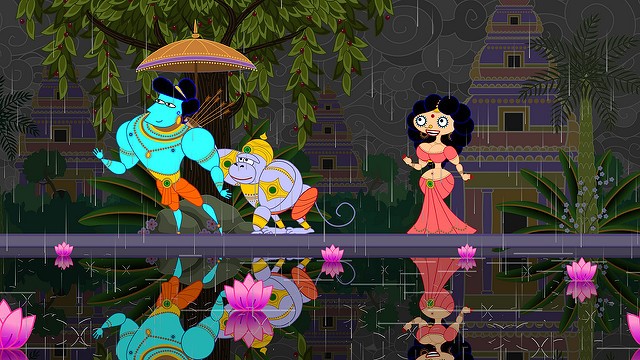Jackson Nock is a senior from Denver, Colorado. He is a double major in International Studies and Religious Studies with a minor in Arabic and Middle Eastern Studies.This post was written as part of Prof. Ramey’s REL 322: Tales from Asia course.
When we think of art, we think of a world in which creativity and expression know no bounds. However, when certain stories are labeled as “religious” or “sacred” as opposed to “non-religious,” we seem to look at art differently.
In my REL 322 class we have been focusing on the Indian epic the Ramayana. What I have found most interesting about this story is the number of tellings and depictions that exist. Recently, we watched the film Sita Sings the Blues, an animated film based on the Ramayana produced by American artist Nina Paley. Paley’s telling of the Ramayana received criticism for its portrayal of certain characters in a negative light and a number of Hindus found the film offensive.
Similarly, the comic book series The 99 written by Naif Al-Mutawa has faced criticism in its portrayal of characters. The 99 is about a team of superheroes each based on one of the 99 attributes of Allah found in Islamic traditions and is generally directed toward a younger Muslim demographic. The comic is banned by the Saudi government and ISIS members have even called for the killing of Al-Mutawa.
These two instances raise questions over how far artistic license extends. Are there certain topics, themes, or stories that should be left off limits? Should “religious” or “sacred” stories be told only in a certain way in order to prevent possible cultural appropriation? The problem with these questions is that it looks at stories such as the Ramayana or the 99 attributes of Allah through these “religious” or “sacred” labels.
As Dr. Ramey notes in his blog post “What if Harry Potter is Sacred,” “When we label something as ‘sacred,’ that designation often changes how we engage it.” But why do we use these labels to describe certain texts or stories in the first place? In his book Capitalizing Religion, scholar Craig Martin argues “when there is a chafing relationship between [a] state’s practices and the practices of a particular civil institution, the latter may cry foul on the grounds of ‘freedom of religion'” (Martin, 44). Thus, religious groups, Martin argues, use “religious” or “sacred” labels in order to reduce the reach or scope of “secular” institutions in their private lives (Martin, 44). Could it be possible to extend this argument into the realm of artistic license?
In both the cases of Paley’s Sita Sings the Blues and Al-Mutawa’s The 99, we see religious groups protesting the content of artwork they see as degrading to things they hold as “religious” or “sacred.” If we are to use Martin’s line of logic, the use of these labels to describe the Ramayana or the 99 attributes of Allah is a way of limiting the scope of artistic license on them. But is this healthy? Should artists refrain from creating their work out of fear of backlash?
Despite where you stand on this issue, the important thing to realize is that using the terms “religious or “secular” to describe certain stories has an impact on the way people think about them. This, in effect, has discouraged artistic license in regards to them. Therefore, it is important to examine how these types of labels may be affecting the telling or retelling of a story when you examine it.
